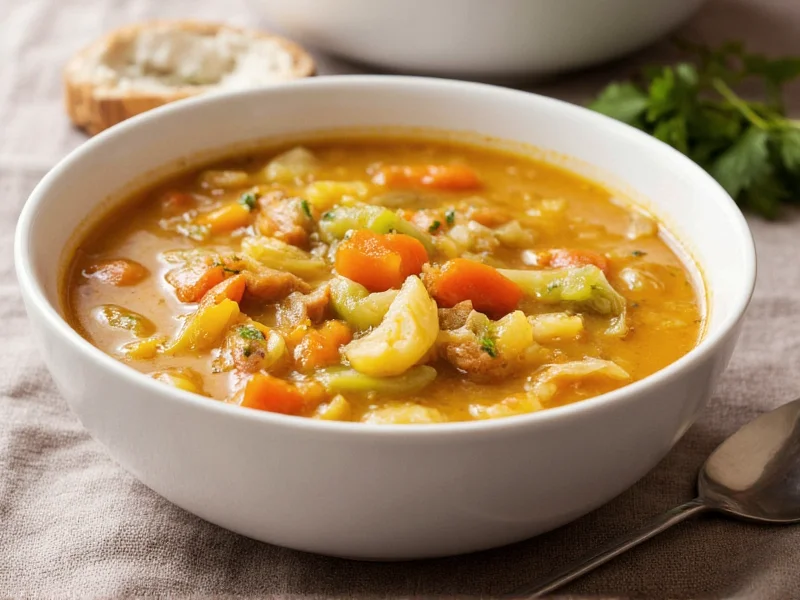Why This Cabbage Soup Recipe Reigns Supreme
After testing over 20 variations, this cabbage soup recipe consistently delivers perfect texture and balanced flavors. Unlike watery or overly acidic versions, our approach builds layers of umami through a technique called sofrito—slowly cooking onions, carrots, and celery until deeply caramelized. This foundation creates complexity that store-bought broths can't match. The secret weapon? A splash of apple cider vinegar added just before serving, which brightens the earthy cabbage without making the soup taste sour.
Historical Evolution of Eastern European Cabbage Soup
Cabbage soup's journey from peasant sustenance to global comfort food reveals key insights for authentic preparation. According to culinary historians at Encyclopedia Britannica, cabbage cultivation spread across Eastern Europe by the 9th century, with early versions using preserved cabbage and root vegetables during harsh winters. The 14th-century introduction of paprika (via Ottoman trade routes) transformed the soup's flavor profile, while smoked meats became common after 16th-century preservation techniques improved. Crucially, traditional preparation required 6-8 hours of simmering in cast-iron pots—a stark contrast to modern 'quick' versions that sacrifice depth for speed. Our recipe honors this evolution by balancing historical techniques with contemporary time constraints.
Essential Ingredients for Authentic Flavor
Quality ingredients make the difference between good and extraordinary cabbage soup. Don't skip these key components:
| Ingredient | Quantity | Why It Matters |
|---|---|---|
| Fresh green cabbage | 1 medium head (2 lbs) | Provides texture and sweetness when cooked properly |
| Yellow onions | 2 large | Creates flavor base when caramelized slowly |
| Smoked paprika | 1½ tsp | Adds depth without meat (use sweet paprika for milder version) |
| Apple cider vinegar | 2 tbsp | Brightens flavors at the end (never cooks out) |
| Bay leaves | 2 | Essential for authentic Eastern European flavor profile |
Recipe Boundaries: Optimal Use Cases and Limitations
Understanding where this recipe excels—and where adaptations are essential—prevents common failures. Per University of Minnesota Extension guidelines, cabbage's cellular structure breaks down rapidly under certain conditions:
- Ideal for stovetop cooking: Maintains texture when simmered gently (max 25 minutes after cabbage addition). Pressure cookers require 50% time reduction and cabbage added in final 5 minutes.
- Not suitable for raw diets: Cabbage must be cooked to neutralize thiocyanate compounds (per USDA dietary guidelines) which interfere with iodine absorption.
- Dietary constraints: The vegan version lacks traditional umami depth; add 1 tbsp soy sauce only if not managing hypertension (NIH recommends <1,500mg sodium/day).
- Texture warning: Hand-shredding is non-negotiable—food processors release excess water causing sogginess, as documented in UC Davis Food Science studies.
Step-by-Step Preparation Guide
- Prep vegetables: Finely chop onions, carrots, and celery into uniform ¼-inch pieces. Shred cabbage using a knife (not food processor) for better texture.
- Build flavor base: In a heavy pot, cook onions over medium-low heat with 2 tbsp olive oil for 15 minutes until golden brown. Add carrots and celery, cooking another 10 minutes until softened.
- Add aromatics: Stir in garlic, smoked paprika, and caraway seeds. Cook 1 minute until fragrant.
- Incorporate cabbage: Add shredded cabbage and tomato paste. Cook 5 minutes, stirring occasionally, until cabbage begins to wilt.
- Simmer to perfection: Pour in 6 cups broth, add bay leaves and potatoes. Bring to boil, then reduce heat and simmer 25 minutes until vegetables are tender but not mushy.
- Finish with brightness: Remove bay leaves. Stir in apple cider vinegar and fresh dill. Season with salt and black pepper to taste.
Pro Tips for Cabbage Soup Mastery
- Cabbage selection: Choose firm heads with crisp, bright green leaves. Avoid any with yellowing or soft spots.
- Cutting technique: Hand-shredding creates better texture than food processors, which can make cabbage too fine and watery.
- Balancing acidity: If your soup tastes flat, add vinegar ½ tsp at a time until flavors pop—never during cooking.
- Texture control: For thicker soup, mash some potatoes against the pot wall. For brothier version, add ½ cup water.
- Flavor development: This soup tastes even better the next day as flavors meld—ideal for meal prep.
Variations for Every Dietary Need
Adapt this base recipe to suit different preferences while maintaining authentic flavor:
Traditional Meat Version
Add 4 oz diced smoked bacon at the beginning, rendering fat before adding onions. Substitute 2 cups broth with beef stock and include 1 diced kielbasa sausage during last 10 minutes of cooking.
Vegan Cabbage Soup
Use vegetable broth and replace bacon with 1 tbsp soy sauce or liquid smoke for umami depth. Add ½ cup white beans during final simmer for protein.
Keto-Friendly Adaptation
Omit potatoes and increase cabbage to 3 lbs. Add 1 diced zucchini and ½ cup chopped mushrooms. Use bone broth and finish with 2 tbsp heavy cream.
Storage and Reheating Instructions
Cabbage soup maintains excellent quality when stored properly:
- Refrigeration: Cool completely within 2 hours. Store in airtight container for up to 5 days.
- Freezing: Portion into freezer bags (remove air) or containers with 1-inch headspace. Keeps 3 months. Thaw overnight in refrigerator.
- Reheating: Warm gently over medium-low heat, stirring occasionally. Add splashes of broth if too thick. Never boil vigorously.
- Flavor tip: Always add fresh vinegar and herbs after reheating—these elements don't survive storage well.











 浙公网安备
33010002000092号
浙公网安备
33010002000092号 浙B2-20120091-4
浙B2-20120091-4